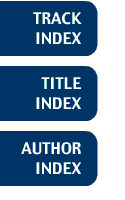
Track: Health Care
Small Area Analysis: Creating Regions for Health Data Analysis
Gregory ElmesSara Loftus , Elizabeth Barnett, Joel Halverson, Valerie Braham, Luc Anselin
In health data analysis a trade-off exists between the need for high spatial resolution and statistical requirements for calculating stable estimates of disease rates. Great value is added to information about the distribution of disease, access to health care, and impact of intervention projects when the geographic details pertain to small areas. Conversely the calculation of meaningful statistics such as mortality and morbidity rates requires minimum threshold size of both the denominator (population at risk) and numerator (disease count) data. This statistical problem is related to the uneven distribution of population groups and disease occurrence and is particularly acute for minority populations or populations stratified by gender, age, ethnicity, and so forth. Rural regions present greater problems than urban areas, resulting in an uneven availability of health-related information that might adversely influence health care policy making. The current project compares grouping heuristics and location-allocation approaches developed as AMLs in ArcInfo that maximize the number of small areas subject to constraints on minimum population size. Socioeconomic data are also included to provide geographic consistency to the resulting statistical areas. Examples are presented from a study of heart disease in the Appalachian region.
Gregory Elmes
West Virginia University
425 White Hall
MORGANTOWN, WV 26506-6300
USA
Telephone: (304) 293 - 5603 ext 4325
Fax: (304) 293 6522
E-mail: gelmes@wvu.edu